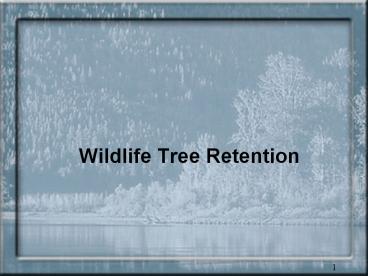Wildlife Tree Retention - PowerPoint PPT Presentation
1 / 23
Title:
Wildlife Tree Retention
Description:
Over 80 species of wildlife are critically dependent on ... Design patches to minimise windthrow. If no valuable trees then choose for long term retention ... – PowerPoint PPT presentation
Number of Views:53
Avg rating:3.0/5.0
Title: Wildlife Tree Retention
1
- Wildlife Tree Retention
2
Wildlife tree retention
- One of most valuable components of stand-level
biodiversity - Over 80 species of wildlife are critically
dependent on wildlife trees - WTR is an important part of forest stewardship
and ecosystem integrity
3
Wildlife tree retention
- Legal Definitions
- Wildlife tree - a tree or a group of trees that
are identified in an operational plan to provide
present or future wildlife habitat (OPR sec. 1) - Dangerous tree - any tree that is hazardous to
workers because of location lean, physical
damage, overhead hazards etc. (WCBR sec 26)
4
Ecological Guiding Principles
- Choose wildlife trees considering
- areas with valuable wildlife tree attributes
- uncommon species (with wildlife value)
- leaving a range of patch sizes and individual
retention - interpatch distance (500 m)
5
Ecological Considerations
- Retention is for a minimum of one rotation
- Design patches to minimise windthrow
- If no valuable trees then choose for long term
retention - leave downed trees for CWD
6
Salvage
- THPR Sec. 28 - no salvage in WTP unless approved
in SP or in writing from DM - Salvaged WTPs should be replaced
7
Rocks, swamps marginal areas
- Max of .25 ha of non-treed area within a patch
- marginally treed areas count as a of full
stocking
8
Seed and Shelterwood trees
- Can count to retention target if left for full
rotation
9
Stubbing
- Encouraged as compliment for wildlife tree
retention - Not recommended as contributing towards retention
target
10
Wildlife tree retention
- Forest Practices Code Timber Supply Analysis
document (Feb 96) estimated that wildlife tree
retention would have a - 1.8 Provincial impact on timber supply, or
- 2.8 Provincial impact in the absence of LU
objectives for OGMAs
11
Wildlife tree retention
- Why is WTR being addressed through landscape unit
planning - LU objectives will ensure a sound legal basis
for WTR management - FDP is guided by and must be consistent with the
HLP objectives
12
Wildlife tree retention
- What needs to be done?
- Calculation of WTR
- Determine total WTR
- Set THLB cap (default is 50 or 25)
- Setting WTR objectives
13
Wildlife Tree Retention - Calculation
14
Table A3.1
15
(No Transcript)
16
WTR- Variation in THLB cap
- main reason for allowing variation is to ensure
subzones with little non-contributing have
adequate WTR - calculated PRIOR to setting LU objectives
- result is
- varies THLB cap
- overall impact stays constant
17
Wildlife tree retention - calculation
- Determine the THLB WTR target
- interior example - maximum 50 of total WTR
target will be retained from the THLB. - Calculate the THLB WTR target hectares by
multiplying the total WTR percentage by 50 and
by the crown forested area. - 8 x 50 x 58,957 2,358 hectares
18
WTR Spread Sheet
19
Stand level variation
- LU objective may allow variation at the stand
level for biological reasons - Controlled within each FDP
- Total WTR objective and THLB cap met over the
cutblocks within the FDP without exceeding the
THLB cap
20
Wildlife tree objective
- Retain 8 of each cutblock within the SBSdk as
wildlife trees subject to the following - All NC with suitable wildlife trees must first be
used to achieve the overall cutblock target - A maximum of 4.8 of each cutblock can be
retained for wildlife trees located in the THLB - It is acceptable to vary from the 8 and/or 4.8
for biological reasons, provided the average of
the cutblocks within the SBSdk equal the 8 and
up to 4.8 when averaged over all cutblocks in
the SBSdk subzone within the FDP area.
21
Wildlife tree strategy
- Example Strategy
- Every block should have some area reserved for
WTR - Where practical, retain wildlife trees in both
patches and individually
22
Wildlife Tree Retention
- Tracking
- SP mapping to .25 ha
- Forest Cover mapping 2 ha and greater
- Auditing/Monitoring
- to be based on aggregate of many SPs
- developed over next several years
23
Wildlife Habitat Value































